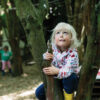
by Gemma Parker
CraZy BeanZ
After an incredibly challenging year, many more children are struggling with their mental health and wellbeing. Our children are sponges and soak up everything. It was impossible for them to go through the last year and it have no impact on them. As well as their own experiences, they mirror our emotions, even when we think we have been expert geniuses at masking them.
How can we help our children at home with these big changes?
One way is through storytelling. Children gain knowledge and understanding through stories and play.
Where to start?
We can’t hide our children from uncomfortable emotions and experiences, as much as we wish we could. We need to equip them with tools to help them process and learn from all their experiences.
It starts by ‘feeling’ and ‘naming’ our emotions. All emotions are important and noticing them really helps us to work through them. You can help your children name their emotions and connect with them. For example: Comfortable emotion – “You looked like you were feeling very excited when the robin took the bread.” Uncomfortable emotion – “I think you were feeling embarrassed when you dropped your drink just now.”
By connecting with your child’s emotions, you are acknowledging them as an individual and helping them name what they are feeling. This is ownership and it so powerful.
Big, big, BIG emotions!
When a child is experiencing a big emotion, they are in a triggered state. It is best to comfort them at this point. Later when they are more relaxed, we can start to look at the magic of story telling and work through the emotion.
Here’s how…
Make a story together. “Let’s tell a story about a someone else who got embarrassed. We need a character, who should we choose?”
With your child, create a story which includes the emotion or experience you are addressing. They can choose characters and settings. Make gentle suggestions while including your child in the process. This helps you both work through the emotion in a creative way!
Here’s an example of this process…
Adult: We have chosen a dragon and what’s his name?
Child: Bob the Dragon!
Adult: OK Bob the Dragon it is. Once upon a time there was a dragon called Bob the Dragon. Bob lived in a… where did he live?
Child: In a cave!
Adult: Bob lived in a cave at the top of a very tall mountain. One morning Bob was tidying up his cave getting ready to go out. He had decided to go the café to meet… who is he going to meet?
Child: He is going to meet a robot and a ghost with big eyes…
The adult manages the narrative and the child creates the elements. As you proceed, your children will get more engaged and creative. This is something you can do anywhere, even in the car! This is also great for settling sibling quibbles.
You can then play the story together with toys or with drama. Just make sure you are including that big emotion so your child can experience it from outside themselves. Seeing the emotion helps them to connect with it the next time they experience it.
Play with toys.
This is the same process as making a story together, only you use toys and props. Children take more control with this method. You’ll need to steer them back every now and again to the emotion intended, but do roll with the creativity. It is magical and lots of fun!
Comic strip.
Make a story together as a comic strip. This process is better for older children who will happily sit for some time. You will have lots of time to talk with your child and connect with them. Drawing together and collaborating with your child will strengthen your bond and make them feel safer exposing their emotions.
Remember these key points:
• No judgment.
Allow your children to have their emotions. Create a space where they feel they can open up to you. Sometimes they may disclose things to you that would trigger you, but if you can remain calm and thank them for their honesty then work through the process together, you will have a child who can come to you no matter what.
• Tailor your debrief.
It is important to discuss the emotions as you play them out, but we don’t want to kill the magic of the story and lose their interest. Adults can talk for much longer than children, so we must remember when to reign it in and return to the narrative.
• Lose yourself in the magic!
Be there in the moment and present with your child. These are fundamentals in wellbeing and if you are modelling this and experiencing it with your child, they will mirror you.
I hope these activities help you and your child work through some big emotions and changes but most of all, I hope you have fun trying!
CraZy BeanZ specialise in children’s entertainment and wellbeing.
Story telling is at the heart of all their work, taking children on big adventures.
Covering Sussex, Surrey and Kent, you can book them for party entertainment, school and club workshops and toddler workshops.
www.CrazybeanZ.co.uk 07955 854 881











